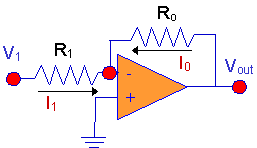| Operational Inverting Amplifier |
After all is said and done, we can solve for the
output voltage, and doing that we find:
Vout
= - V1 R0 / R1
There are two things to note about this expression
for the output voltage.
-
The input voltage is multiplied
by a constant that depends only upon the two resistors, R0
and R1.
-
No property of the amplifier
shows up in the final expression.
-
Properties of the amplifier
that are used in the argument for this expression are:
-
Finally, note that pesky minus
sign.
And we reiterate the conditions/assumptions under
which this result is true.
-
The Input Voltage Difference,
(V+ - V-), is very small because the gain is
large and the output is not overly large.
-
The current flowing into the
input terminals is negligible because the input resistance is small.
The result
above - for the output voltage - is the result we wanted. It gives the
output voltage in terms of the input voltage and the two resistors in the
circuit. Amazingly, no property of the OpAmp shows up in this expression
although the presence of the OpAmp in the circuit is what makes it work the way
it does. The op-amp doesn't show up in the final expression for the
output, but the circuit wouldn't work without the op-amp. Finally, you
might want to read the
note on gain - especially since it relates to this circuit.
Problems & Questions
Q1.
In this circuit, what is the expression for the ratio of output voltage to input
voltage (Vout/V1)?

|